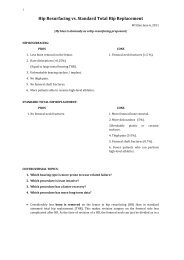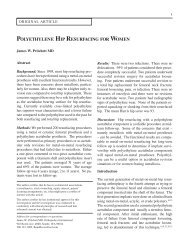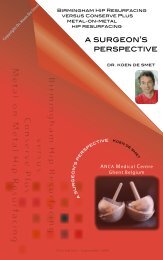Hip and Knee Arthroplasty - Surface Hippy Guide to Hip Resurfacing
Hip and Knee Arthroplasty - Surface Hippy Guide to Hip Resurfacing
Hip and Knee Arthroplasty - Surface Hippy Guide to Hip Resurfacing
Create successful ePaper yourself
Turn your PDF publications into a flip-book with our unique Google optimized e-Paper software.
Effect of Bearing <strong>Surface</strong><br />
For the first time the Registry is reporting the<br />
effect of bearing surface on the early <strong>to</strong> mid term<br />
outcomes of primary conventional <strong>to</strong>tal hip<br />
replacement.<br />
The Registry would advise caution in the<br />
interpretation of these initial analyses. The<br />
relationship between bearing surface <strong>and</strong> other<br />
fac<strong>to</strong>rs known <strong>to</strong> be important <strong>to</strong> the outcome of<br />
joint replacement is complex. The current period<br />
of follow up is short <strong>and</strong> the Registry is yet <strong>to</strong><br />
examine many of these fac<strong>to</strong>rs.<br />
The Registry has classified bearing surface in<strong>to</strong><br />
four categories; ceramic on polyethylene, ceramic<br />
on ceramic, metal on polyethylene <strong>and</strong> metal on<br />
metal. There is a fifth category that relates <strong>to</strong> a<br />
small number of procedures where the bearing<br />
surface is yet <strong>to</strong> be classified by the Registry.<br />
This type of generic analysis is dependent on the<br />
Registry being able <strong>to</strong> define the required feature<br />
(attribute) of each individual prosthesis. The<br />
Registry is working <strong>to</strong> classify the remaining<br />
prostheses <strong>to</strong> complete this process, however it<br />
is labour intensive <strong>and</strong> takes time, particularly for<br />
those prostheses that are no longer used. As the<br />
majority of prostheses have been classified <strong>and</strong><br />
the outcome of the unclassified group does not<br />
vary considerably from the defined categories, it<br />
was decided <strong>to</strong> present these initial analyses<br />
rather than wait until classification has been<br />
completed.<br />
The bearing surface with the highest seven year<br />
cumulative percent revision is metal on metal<br />
(4.4%), followed by ceramic on polyethylene<br />
(3.5%), metal on polyethylene (3.3%) <strong>and</strong><br />
ceramic on ceramic (3.1%). After adjusting for<br />
age <strong>and</strong> gender metal on polyethylene bearing<br />
surface has a significantly lower risk of revision<br />
compared <strong>to</strong> the other three bearing surfaces<br />
(Tables HT25 <strong>and</strong> HT26 <strong>and</strong> Figure HT21).<br />
Bearing surfaces have differences in the risk of<br />
revision depending on head size. For femoral<br />
component head size less than or equal <strong>to</strong><br />
28mm, metal on polyethylene has the lowest<br />
cumulative percent revision at seven years<br />
(3.4%). Compared <strong>to</strong> metal on polyethylene,<br />
ceramic on polyethylene <strong>and</strong> ceramic on ceramic<br />
have a significantly higher risk of revision,<br />
however metal on metal is not significantly<br />
different (Tables HT27 <strong>and</strong> HT28 <strong>and</strong> Figure<br />
HT22).<br />
For femoral component head sizes greater than<br />
28mm, metal on polyethylene <strong>and</strong> ceramic on<br />
polyethylene have the lowest cumulative percent<br />
revision at three years (1.4% <strong>and</strong> 1.3%<br />
respectively). Metal on metal has a significantly<br />
higher revision rate compared <strong>to</strong> the other three<br />
bearing surfaces. Ceramic on ceramic has a<br />
significantly higher revision rate compared <strong>to</strong><br />
metal on polyethylene <strong>and</strong> ceramic on<br />
polyethylene (Tables HT27 <strong>and</strong> HT28 <strong>and</strong> Figure<br />
HT23).<br />
The Registry has also compared revision rates by<br />
femoral component head size for each bearing<br />
surface. Femoral components greater than<br />
28mm have significantly lower revision rates<br />
compared <strong>to</strong> femoral components less than or<br />
equal <strong>to</strong> 28mm for all bearing surfaces with the<br />
exception of metal on metal. For metal/metal<br />
bearing surfaces there is no significant difference<br />
in the rate of revision between femoral<br />
component head sizes (Figures HT24-HT27).<br />
Prosthesis Specific Outcomes<br />
The outcomes of the most commonly used stem<br />
<strong>and</strong> acetabular combinations for primary<br />
conventional <strong>to</strong>tal hip replacement are listed in<br />
Tables HT29-HT34. There are two tables for<br />
cemented, cementless <strong>and</strong> hybrid (femoral<br />
cemented) prosthesis combinations with over 300<br />
procedures. The first table provides information<br />
on the number of procedures, the number of<br />
revisions <strong>and</strong> the revisions per 100 observed<br />
component years. The second table provides the<br />
yearly cumulative percent revision. It is not<br />
possible or meaningful <strong>to</strong> present the outcomes<br />
of all recorded combinations as many<br />
combinations involve small numbers of<br />
procedures. There are 1,249 combinations for<br />
primary conventional <strong>to</strong>tal hip replacement<br />
recorded by the Registry (128 more combinations<br />
than recorded last year). Of these, 69 stem <strong>and</strong><br />
acetabular combinations have over 300<br />
procedures reported. Although the listed<br />
combinations are only a small proportion of the<br />
possible combinations, they represent 77.9% of<br />
all primary conventional <strong>to</strong>tal hip replacements.<br />
These tables allow comparison of outcomes for<br />
the most commonly used combinations by<br />
Australian surgeons. It is worthwhile noting that<br />
the group ‘other’ is the combined outcome of all<br />
prosthesis combinations with less than 300<br />
procedures.<br />
There are 11 primary conventional <strong>to</strong>tal hip<br />
stem/acetabular combinations with greater than<br />
300 procedures using cement fixation. All have<br />
over 1,000 observed component years <strong>and</strong> the<br />
number of revisions per 100 observed component<br />
years varies from 0.1 <strong>to</strong> 0.9 (Table HT29). Of<br />
those with a seven year cumulative percent<br />
revision the least revised combinations are the<br />
MS 30/Low Profile Cup (0.8%), the Exeter/Exeter<br />
(3.0%) <strong>and</strong> the Spectron EF/Reflection (3.0%)<br />
(Table HT30). Regardless of fixation, the MS<br />
30/Low Profile cup has the lowest seven year<br />
55






